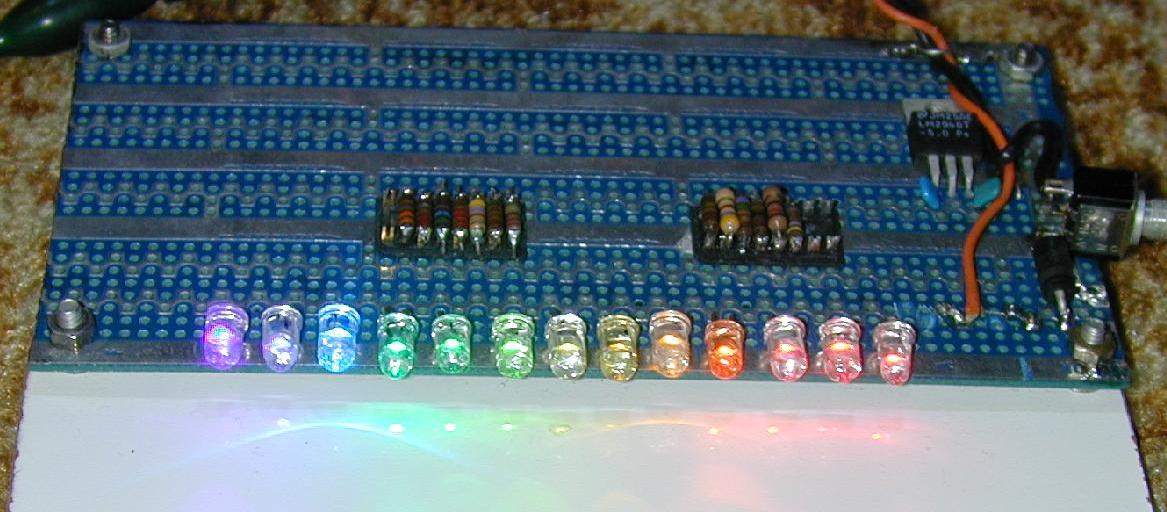13 Color LED Rainbow


13 Color LED Rainbow
(C) G. Forrest Cook February 8, 2005Introduction
Only a few years ago, the choice of LEDs was limited to IR, red, yellow, and green. The LED manufacturers have been busy extending the spectrum, and filling in the gaps. The latest generation of organic LEDs (OLEDs) has added some dazzling new colors to the spectrum. This circuit uses a set of 13 differently colored LEDs to generate a full color spectrum. The photo does not fully represent the colors generated due to camera limitations. The real-world display is very eye-catching. If you want to "trick out" your PC, this circuit is for you. Forget about those boring blue PC light displays
.Specifications
Operating Voltage: 6-12V DC Operating Current: 145ma at 12V DC
Theory
The LM2940T-5.0 low dropout voltage regulator converts the 6-12V DC input power to regulated 5 Volts. It was chosen over a standard 7805 regulator so that the circuit could maintain regulation while operating on a 6V battery. The 1N4001 diode protects the circuit from reverse polarity, if a battery or power supply capable of generating over 1 amp is used, a 1 amp fuse should be installed between the supply and the circuit. The 5 Volts is used to drive each of the LEDs through individual current limiting resistors. The resistor values were determined experimentally for equal brightness. Values are given as examples only, different sources of LEDs will require different resistor values. Resistor selection turns out to be the most difficult part of the circuit's construction. A 100 ohm resistor in series with a 1K pot could be used in place of each resistor if individual brightness adjustments are desired. The table below lists the LED colors and wavelengths
.| LED Color | Wavelength | Description |
|---|---|---|
| Deep Red | 700nm | - |
| Red | 660nm | traditional red |
| Orange Red | 635nm | "high efficiency" red |
| Orange | 623nm | also called red orange |
| Amber | 594nm | - |
| Yellow | 588nm | traditional yellow |
| Yellow Green | 567nm | traditional green |
| True Green | 523mn | - |
| Cyan | 501nm | verde green, blue green |
| Aqua | 495?nm | - |
| Deep Blue | 470nm | ultra blue |
| Powder Blue | 430nm | first generation "powder blue" |
| Violet | 410nm | - |
Construction
The circuit was built on a prototype perforated board with printed solder pads. The circuitry is hand-wired on the back side of the board. Care should be taken when soldering to the LEDs, a clip-on heat sink should be used while soldering the leads. Care should be taken to avoid zapping the LEDs on the violet side of the spectrum, they are sensitive to static electricity. The circuit board can be mounted on a piece of white hardboard, the white paint reflects the colors nicely.
Use
Apply power to the circuit and enjoy the colorful glow. Do not stare directly into the array at close range for extended periods, some of the LEDs are extremely bright.
Taking The Circuit Further
The spectrum could be extended on both the IR and UV sides. A brief scan through the Mouser catalog indicates the availability of these IR wavelengths: 940nm 880nm, 875nm, 870nm, 850nm. UV LEDs at 400nm, 395nm and 380nm are also available. There are also many LED colors available with wavelengths between the 13 colors shown, the colors selected were chosen for an evenly spaced color spectrum.
An open-collector LED driver circuit could be connected to the negative LED leads for computer control.
The circuit could be used in conjunction with a photo detector for characterizing optical filter curves. Typically, the photo detector output is sent to a logarithmic converter, the log-ratio of the direct light versus the filtered light characterizes the attenuation at a given wavelength.
Parts
Most of the LEDs were purchased from Digi-Key, Jameco, and Mouser. All of the parts were T1-3/4 size, clear packages were used wherever possible. LEDs from different manufacturers may have different focus characteristics. All of the resistors are 1/4 Watt parts. LED part numbers are not available, the rainbow was assembled from parts that were accumulated over several years. Beware that different LED manufacturers use different names for their colors, the wavelength is the best indicator of the color. The Aqua LED is the most difficult part to find,
All Electronics carries them, although the wavelength is unspecified. Another source of colored LEDs is Theledlight, they have a nice Led Color Chart.I find it somewhat amazing that, to my knowledge, no LED manufacturer has produced a commercial packaging of colored LEDs similar to this project (as of 2006). It would be wonderful if a company would assemble 8 or 10 unique colors into a standard DIP VU meter LED block. It's only a matter of time, I would love to hear about such a part if it ever becomes available.
Source:www.solorb.com






